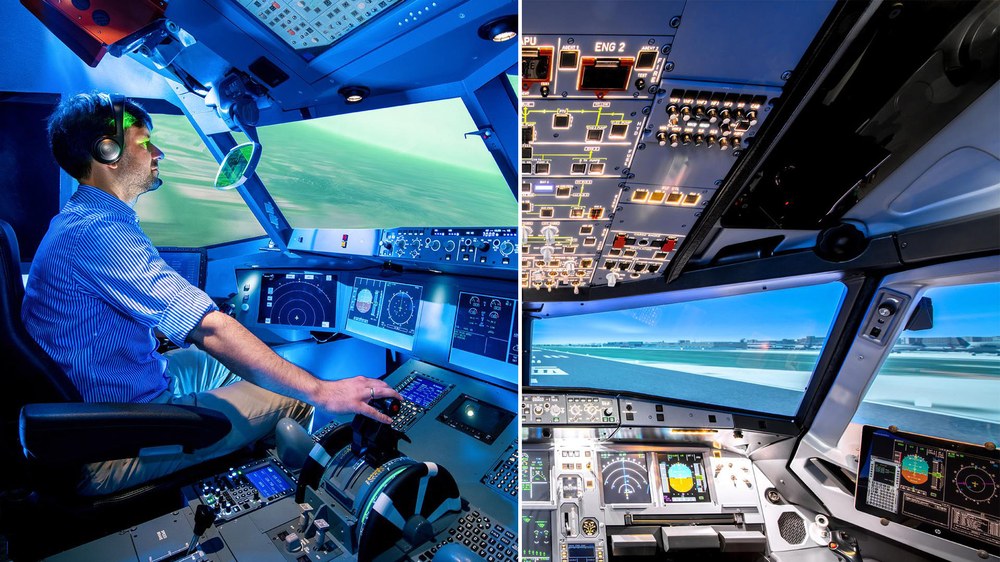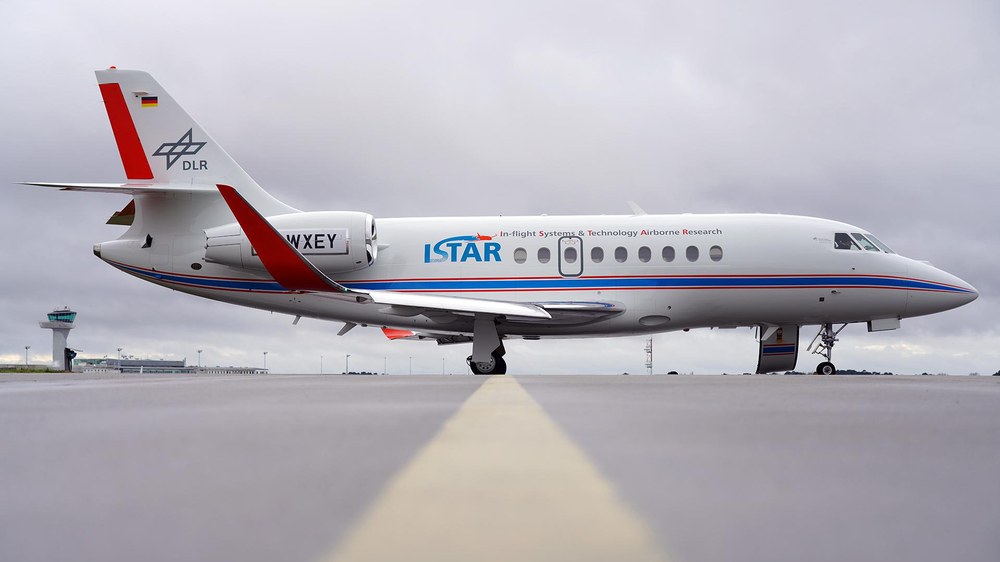NICo

In the NICo (Next Generation Intelligent Cockpit) project, the concept and architecture for a highly automated cockpit of the future is being developed and investigated within the scope of a number of simulator studies in the cockpit simulator GECO (Generic Experimental Cockpit) and the full-motion simulator AVES (Air Vehicle Simulator). Selected NICo systems will be demonstrated through flight tests in the DLR research aircraft ISTAR (In-flight Systems and Technology Airborne Research).

In the NICo project, future single-pilot operations, meaning flights with only one pilot on the aircraft, are being investigated and a new virtual co-pilot, partly based on artificial intelligence (AI), is being developed. NICo also considers the new possibilities which are emerging as a result of the rapidly increasing interconnection of the aircraft with other traffic participants as well as with air traffic control (ATC) and the airline operation centre. The possibility of a remote co-pilot, who monitors the flight from a ground position and, if necessary, takes control of the aircraft, is also being investigated. In the short term, the research results should also contribute towards a reduced workload and increased safety in today's two-pilot operations (multi-pilot operations).
Future systems and procedures will have a major influence on the current operation methods in the cockpit and on the ground. NICo will therefore also address the resulting impact on pilots and remote co-pilots. The resultant amended requirement profile for future pilots will also be investigated.
Challenges arising through single-pilot operations
For some time now, single-pilot operations has been a familiar term, particularly in business and military aviation. Single-pilot operations place exceptional demands on the pilots. Increased workloads, higher traffic densities, the integration of other traffic participants into the airspace or an increasing danger resulting from weather phenomena necessitate more extensive pilot support and a more intensive networking of the aircraft with its surroundings. Through concepts such as an intelligent Virtual Co-Pilot and a remote co-pilot, this necessary enhanced support can be realised. Additional, coordinated assistance functions can reduce the strain on pilots, thereby significantly increasing their performance and, as a result, the safety of the flight in combination with automation. An additional challenge is error management, which currently places the highest demands on the crew in the two-man cockpit (multi-pilot operations). In future single-pilot operations, it is essential to ensure that system errors continue to be processed both quickly and safely and that the best-possible decisions are taken in order to prevent flight safety from being endangered at any time.
In addition to internal factors, such as possible system errors in the aircraft, pilots must also consider the external hazard factors for the planned flight when making decisions. This begins with the current and future weather conditions (thunderstorms, wake vortices, icing) and extends across difficult terrain and high traffic density in the air as well as demanding take-off and landing conditions.
Support through a virtual co-pilot
For the support and relief of the pilots, a Virtual Co-Pilot is being developed within NICo on the basis of artificial intelligence. The interaction of the pilot with the Virtual Co-Pilot must be as simple as possible. Future functions of the Virtual Co-Pilot must not only be intuitively operable; their behaviour must also be understandable and comprehensible for the pilot.
The NICo research work into future cockpit functions for a Virtual Co-Pilot will focus on the interface to the pilot and on assistance and automation functions. These functions are meant to ease the handling of system faults, emergency situations, or situations which, if not properly handled, would become emergency situations.
The fault analysis and diagnostics capabilities of the Virtual Co-Pilot also provide the foundation for improved human-machine interaction in the case of system failures in current multi-pilot operations. The current safety level is very high and has been continuously improved in the past. Still, solutions tailored for handling complex failure cases could help reaching even higher levels of safety; in particular for faults leading to numerous subsequent others faults and system failures. Currently, in such cases and in most aircraft types, pilots would be flooded with an extremely high number of error messages, from which it can be challenging to grasp the most important elements to take the right decision under time pressure. The Virtual Co-Pilot shall perform a consolidated mutli-level fault-detection, isolation, and diagnosis of the root causes and presents its diagnostics in the most intelligible way possible.
Apart from presentation of the faults and their causes, the information displayed to the crew shall emphasize the remaining capabilities of the aircraft. The Virtual Co-Pilot should then support the pilot(s) in managing the onboard systems in taking decisions related to the safe continuation or termination of the flight. Thereby, the current conditions such as weather and traffic are considered. To make future automatic functions more resilient to system failures (particularly sensor errors), the Virtual Co-Pilot should also be capable of providing substitute, possibly synthetic, values from the remaining sensors. The monitoring of the air data systems plays a particularly important role, due to their exposure to external influences and environmental conditions, which could lead to problems such as freezing, obstruction, or bird strike.
Support through a remote co-pilot
A further possibility for supporting the pilots is the Remote Co-Pilot concept. In the NICo project, this special type of ground-based support is being researched in parallel with the virtual co-pilot.
Selected functions which have been identified as being particularly important and helpful for remote-pilot operations will be implemented as prototypes. The helpful functions will not only be developed for single-pilot operations in the long term but should also reduce the workload in current two-man cockpits. The use of a Remote Co-Pilot requires a re-thinking of the classic cockpit layout in the aircraft as well as the consideration of the necessary control station for the operator on the ground. The research into future human-machine interfaces and the development of optimised procedures form the focus.
One Remote Co-Pilot will be responsible for several single-pilot aircraft simultaneously. The remote-pilot centre will provide ground support for several aircraft. Questions regarding the optimal design of the centre, transfers of aircraft between the pilots, and emergency procedures will be addressed in NICo. Due to the physical separation between the pilots on the aircraft and on the ground, secure data-link communication is of crucial importance. Corresponding system requirements and safety assessments are being carried out. As the acquisition and exchange of information via data links between aircraft and ground - and also between several aircraft - are core components of the concepts in NICo, additional aspects of data security are also being considered.
The overall pilot-machine system and the requirements for pilots
NICo is intended to increase the performance of the overall pilot-machine system. For this purpose, the limits of human performance, the so-called "human performance envelope", are being addressed, whilst the acceptance of a Virtual Co-Pilot and/or the interaction of pilots and artificial intelligence in the cockpit is being considered and increased by means of suitable interaction mechanisms ("explainable AI").
The concepts predicted for NICo on the basis of current knowledge have a direct impact on the career development of a pilot. The "captain and first-officer relationship" will be dissolved and pilots will immediately be given full responsibility as single pilots. As a result, the requirements for the selection of suitable candidates will change. On the basis of surveys and simulator studies, the amended requirements profile for future pilots who will be working with the Virtual Co-Pilot or the Remote Co-Pilot will be defined.
During the course of NICo, several simulation campaigns with increasing complexity are planned in collaboration with professional pilots. Selected systems will then be demonstrated in flight tests with the ISTAR.

Publications
C. A. Niermann, Auswertung der Remote Co-Piloten Studie im Projekt Next Generation Intelligent Cockpit (NICo), Deutscher Luft- und Raumfahrtkongress, DLRK 2024 https://elib.dlr.de/207566/
F. Zinn, L. Ebrecht, F. Albers, W. Matthias, D. Niedermeier, Single Pilot Operations - Who Should Do What? Allocating Aviation Tasks to the Performing Cooperators, Human Computer Interaction International 2024 https://link.springer.com/chapter/10.1007/978-3-031-60728-8_21
L. Ebrecht, Automation of the 4-Eyes-Principle and X-Checks - Featuring small High Performance Airplanes, Deutscher Luft- und Raumfahrtkongress, DLRK 2024 https://elib.dlr.de/209401/
J. Gundlach, Entwicklung eines Safety Perfomance Indicators zur Analyse der Vorhersagestabilität von Flughafenwettervorhersagen anhand von Flughafenwetterberichten auf Grundlage freier Wetterdaten, DLR Report 2024 https://elib.dlr.de/207239/
G. Schmitz, JP. Buch, DLR-Projekt NICo: Vorläufige Auswertung einer Online-Pilotenstudie zur Entscheidungsfindung bei der Auswahl eines Ausweichflughafens, Deutscher Luft- und Raumfahrtkongress, DLRK 2023 https://publikationen.dglr.de/?tx_dglrpublications_pi1[document_id]=610107
C. A. Niermann, Single Pilot Forschung in Deutschland, warum sie richtig und wichtig ist, FHP-Symposium 2023 https://elib.dlr.de/202396/
JP. Buch, G. Schmitz, DLR Projekt NICo: Virtuell oder vor Ort? Erkenntnisse über die Onlinedurchführung einer Pilotenstudie zur Entscheidungsfindung, Deutscher Luft- und Raumfahrtkongress, DLRK 2023 https://elib.dlr.de/200988/
C. A. Niermann, D. Niedermeier, Bewertung von Single Pilot Operations im Projekt Next Generation Intelligent Cockpit (NICo), Deutscher Luft- und Raumfahrtkongress, DLRK 2023 https://elib.dlr.de/202395/
F. Zinn, J. della Guardia, F. Albers, Pilot’s Perspective on Single Pilot Operation: Challenges or Showstoppers, Human Computer Interaction, HCI International 2023 https://doi.org/10.1007/978-3-031-35389-5_16
L. Ebrecht, High-fidelity Task Analysis Identifying the Needs of Future Cockpits Featuring Single Pilot Operation with Large Transport Airplanes, Human Computer Interaction, HCI International 2023 https://link.springer.com/chapter/10.1007/978-3-031-35389-5_5
D. Niedermeier, A. Papenfuß, M. Wies, Simulator Study on a Spatially Separated Airline Crew in a Complex Decision-Making Scenario, AIAA Aviation Forum 2023 https://dx.doi.org/10.2514/6.2023-3474
C. A. Niermann, Next Generation Intelligent Cockpit, Hessen Aviation: New Aircraft Architectures 2023 https://frankfurt-holm.de/events/hessen-aviation-new-aircraft-architectures-23-03-2023/
M. Findeisen, J. Küls, C. A. Niermann, T. Hofmann, User centered design process for a high-risk future aerospace system, Applied Human Factors and Ergonomics, AHFE 2023 https://openaccess.cms-conferences.org/publications/book/978-1-958651-74-2/article/978-1-958651-74-2_1
C. A. Niermann, L. Ebrecht, J. Küls, M. Findeisen, T. Hofmann, Development process for a remote co-pilot to support single-pilot operation in a next-generation air transportation system, Applied Human Factors and Ergonomics, AHFE 2023 https://openaccess.cms-conferences.org/publications/book/978-1-958651-74-2/article/978-1-958651-74-2_0
F. Zinn, J. della Guardia, F. Albers, Single pilot operation: Which challenges do pilots envision? Project Next Generation Intelligent Cockpit (NICo), DLR Report 2023 https://elib.dlr.de/194501/
F. Zinn, J. della Guardia, M. Herzog, F. Albers, Single Pilot Operation - Which challenges do pilots envision?, 34th EAAP conference 2022 https://elib.dlr.de/194506/
M. Findeisen, NICo Remote Pilot: Entwicklung eines Remote Pilot HMI mit Fokus auf Notfallfernunterstützung des Flugverkehrs bei Linienflügen, DLR Report 2022 https://elib.dlr.de/190393/
J. Küls, NICo Remote Pilot: Entwicklung eines Remote Pilot HMI mit Fokus auf Kommunikation und Flugführung im Regelbetrieb von Linienflügen, DLR Report 2022 https://elib.dlr.de/190392/
C. A. Niermann, D. Kügler, Next Generation Intelligent Cockpit – Single-pilot operations’ potential to increase flight safety, ECAC News 2021 https://www.ecac-ceac.org/images/news/ecac-news/ECAC-News_74_Artificial_Intelligence.pdf
L. Ebrecht, C. A. Niermann, JP. Buch, D. Niedermeier, Anforderungen und Herausforderungen zukünftiger Cockpits in Verkehrsflugzeugen - Next Generation Intelligent Cockpit, Deutscher Luft- und Raumfahrtkongress, DLRK 2021 https://elib.dlr.de/145291/
D. M. Mielke, M. Schnell, LDACS for Single Piloted Aircraft Operations, Integrated Communications, Navigation and Surveillance Conference, ICNS 2021 https://elib.dlr.de/142701/
Key data
Project | NICo (Next Generation Intelligent Cockpit) |
Participants | Institute of Flight Guidance (Coordinator) |
Duration | 2020 – 2025 |
Funding | Institutional funding |
Website |
